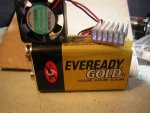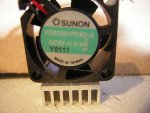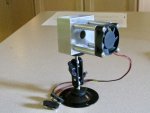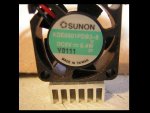UPDATE:
View attachment 62184
I tested the AixiZ heat-sink and there were some surprises. First this is the smallest and the lightest of the heat-sinks and I expected it to be the worst, BUT surprise, it did far better than expected. The other two small heat-sinks could run for only around 5 minutes before hitting the limit of 89F. (15F below the limit of the diode.) The AixiZ ran for 7 minutes before hitting this limit. I can only assume that the larger fins results in greater surface area for cooling. The AixiZ came out to be #2 in my tests.
There was one thing that pissed me off. the AixiZ came with an M3 set screw that was too short. After I screwed it in all the way, the screw would not reach the laser. What the heck? Now I have to go to the store and purchase longer screws, not cool. At $3.95/each they should have paid the fraction of a cent extra for a longer screw. I had to use a 1/4" 40 tripod screw to hold the laser in place.
View attachment 62185
This one performed the best of the group. I ran it for 15 minutes and ended up at 87F with 2F to go before the limit. This was the most costly of the small heat-sinks, but so worth it if you have to keep the heat away from the laser module. This one was #1 for my tests.
View attachment 62186
This gold heat-sink didn't do too bad. I could run for a little over 5 minutes before I reached the limit. This was #3 in my tests. It's only around $4.50 for each. Still for the money, get the AixiZ and save 50 cents.
View attachment 62187
This did the worst in my tests, but could last 5 minutes before reaching my 89F limit. At $3.50 each, the price is reasonable and one could mount it to a metal plate, a metal block, or another heat-sink for additional cooling. This was #4 in my tests.
The one from
ebay may take a while to arrive: SK12 Bearing Linear Rail Shaft Support
https://www.ebay.com/itm/113307812293
So I have no idea how well or badly it will do, but because it clamps around the laser, rather than a set screw, I think it may have some strong points for selecting. AT $1.60 each, it may be worth it to use two of them.









